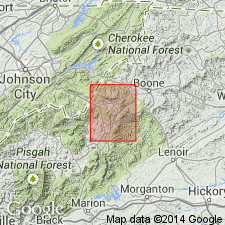
- Usage in publication:
-
- Wilson Creek gneiss*
- Modifications:
-
- Named
- Geochronologic dating
- Dominant lithology:
-
- Quartz monzonite
- Diorite
- Granite
- Gneiss
- AAPG geologic province:
-
- Piedmont-Blue Ridge province
Summary:
Named for Wilson Creek in southeastern part of Linville 15-min quad, Avery Co., northwestern NC. Includes rocks previously mapped as Cranberry granite by Keith (1903) in this area. Excellent exposures may be seen along banks of Wilson Creek. Ranges in composition from diorite to granite with average composition of quartz monzonite. Most of gneiss is not layered, but contains a few lenses and layers of biotite schist in southeast corner of quad. Pegmatite veins and pods are abundant. No total thickness stated, although report states that phyllonite zones 4000 ft thick occur in the rock. Contacts not described. Age is probably early Precambrian based on discordant ages for zircon from a quarry on Wilson Creek about 1000 ft south of Linville quad (Tilton and others, 1959, table 13). Zircon ages range from 640 to 1000 m.y. and suggest a minimum age of 1000 m.y.
Source: GNU records (USGS DDS-6; Reston GNULEX).
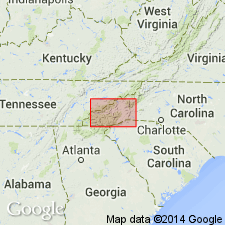
- Usage in publication:
-
- Wilson Creek Gneiss*
- Modifications:
-
- Age modified
- AAPG geologic province:
-
- Piedmont-Blue Ridge province
Summary:
Age changed from early Precambrian to middle Precambrian due to the new three-fold subdivision of Precambrian.
Source: GNU records (USGS DDS-6; Reston GNULEX).
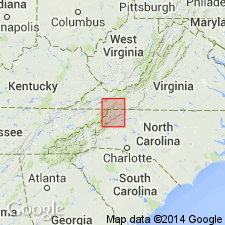
- Usage in publication:
-
- Wilson Creek Gneiss*
- Modifications:
-
- Areal extent
- Revised
- AAPG geologic province:
-
- Piedmont-Blue Ridge province
Summary:
Mapped in Grandfather Mountain window in Avery, Caldwell, and Watauga Cos., northwestern NC as part of informal Elk Park plutonic group. Consists of dominantly equigranular quartz monzonite gneiss and cataclastic gneiss. Ranges in composition from diorite to granite and in texture from equigranular to porphyritic. Includes layered biotite-muscovite gneiss, schist, and metavolcanic rock that may belong to Grandfather Mountain Formation. Age is early Precambrian.
Source: GNU records (USGS DDS-6; Reston GNULEX).
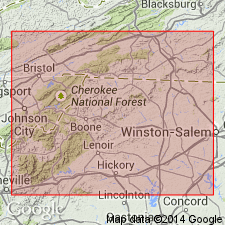
- Usage in publication:
-
- Wilson Creek Gneiss
- Modifications:
-
- Age modified
- Geochronologic dating
- AAPG geologic province:
-
- Piedmont-Blue Ridge province
Summary:
Samples from Wilson Creek Gneiss of Elk Park plutonic group were sampled from Caldwell Co., northwestern NC. Rb-Sr dating techniques on five samples yielded an average model age of 1104 m.y. The reference isochron is shown as 1170 m.y. If the average is close to actual age, then Wilson Creek Gneiss is older than Blowing Rock Gneiss (1027 m.y.) and older than part of Cranberry Gneiss (1063 +/-41 m.y. and 871 +/-17 m.y.).
Source: GNU records (USGS DDS-6; Reston GNULEX).
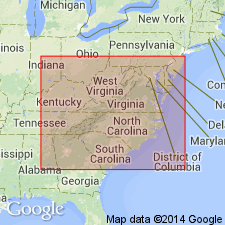
- Usage in publication:
-
- Wilson Creek Gneiss*
- Modifications:
-
- Age modified
- AAPG geologic province:
-
- Piedmont-Blue Ridge province
Summary:
Age changed from middle Precambrian to Proterozoic Y in accordance with new terms from Precambrian subdivisions.
Source: GNU records (USGS DDS-6; Reston GNULEX).
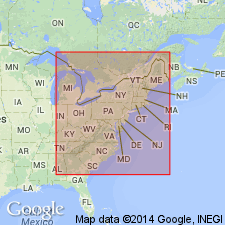
- Usage in publication:
-
- Wilson Creek Gneiss*
- Modifications:
-
- Revised
- Age modified
- Geochronologic dating
- AAPG geologic province:
-
- Piedmont-Blue Ridge province
Summary:
Elk Park plutonic group given formal rank as Elk Park Plutonic Suite. Includes Cranberry Gneiss, Blowing Rock Gneiss, and Wilson Creek Gneiss, all in northwestern NC. Max Patch Granite of Great Smoky Mountains is probably correlative. Grayson Granodiorite Gneiss was retained by Fullagar and Odom (1973) for similar rocks in Grayson Co., southern VA, although Rankin and others (1972) preferred to extend the name Cranberry Gneiss into that area. Seven samples of Elk Park rocks (three reported by Davis and others, 1962, and four previously unreported, but collected by Rankin and analyzed by T.W. Stern) yielded a pooled discordia age of 1079 m.y. Fullagar and Odom reported Rb-Sr whole-rock isochron ages of 1041 m.y. for Cranberry Gneiss from western Watauga Co., NC, and eastern Johnson Co., TN; 1005 m.y. for Blowing Rock Gneiss; and 1149 m.y. for Grayson Granodiorite Gneiss in Grayson Co., VA. Age of Elk Park Plutonic Suite is Proterozoic Y.
Source: GNU records (USGS DDS-6; Reston GNULEX).
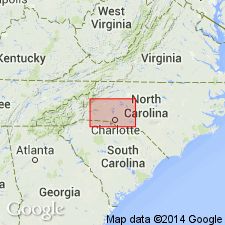
- Usage in publication:
-
- Wilson Creek Gneiss*
- Modifications:
-
- Age modified
- Areal extent
- AAPG geologic province:
-
- Piedmont-Blue Ridge province
Summary:
Age of Wilson Creek Gneiss changed from Proterozoic Y to Middle Proterozoic in accordance with new names for subdivisions of the Precambrian. Occupies part of southeastern corner of quad in Blue Ridge belt. Divided into unnamed granite and granite gneiss units. Included in Elk Park Plutonic Suite.
Source: GNU records (USGS DDS-6; Reston GNULEX).
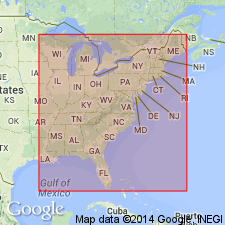
- Usage in publication:
-
- Wilson Creek Gneiss*
- Modifications:
-
- Geochronologic dating
- AAPG geologic province:
-
- Piedmont-Blue Ridge province
Summary:
Wilson Creek Gneiss isotopic ages are as follows: 1) at Mortimer, NC, 206Pb-238U age of 725 Ma, 207Pb-235U age of 849 Ma, and 207Pb-206Pb age of 1001 Ma (Davis and others, 1962; and 2) at Silvervale Falls, NC, 206Pb-238U age of 725 Ma, 207Pb-235U age of 766, and 206Pb-207Pb age of 889 Ma (T.W. Stern and D.W. Rankin, unpub. data).
Source: GNU records (USGS DDS-6; Reston GNULEX).
For more information, please contact Nancy Stamm, Geologic Names Committee Secretary.
Asterisk (*) indicates published by U.S. Geological Survey authors.
"No current usage" (†) implies that a name has been abandoned or has fallen into disuse. Former usage and, if known, replacement name given in parentheses ( ).
Slash (/) indicates name conflicts with nomenclatural guidelines (CSN, 1933; ACSN, 1961, 1970; NACSN, 1983, 2005, 2021). May be explained within brackets ([ ]).

